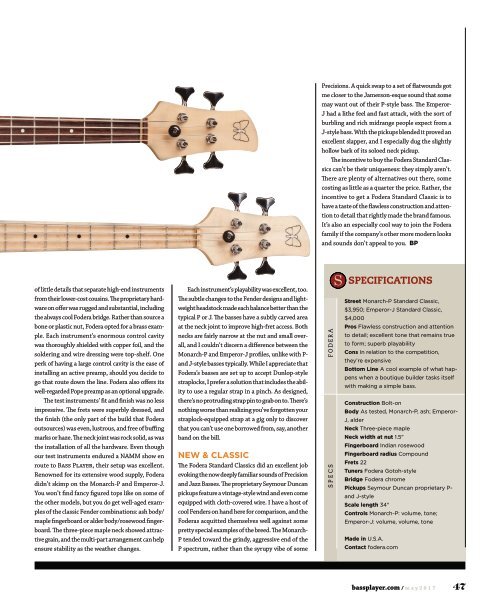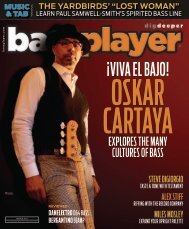BassPlayer 2017-05
BassPlayer 2017-05
BassPlayer 2017-05
Create successful ePaper yourself
Turn your PDF publications into a flip-book with our unique Google optimized e-Paper software.
Precisions. A quick swap to a set of flatwounds got<br />
me closer to the Jamerson-esque sound that some<br />
may want out of their P-style bass. The Emperor-<br />
J had a lithe feel and fast attack, with the sort of<br />
burbling and rich midrange people expect from a<br />
J-style bass. With the pickups blended it proved an<br />
excellent slapper, and I especially dug the slightly<br />
hollow bark of its soloed neck pickup.<br />
The incentive to buy the Fodera Standard Classics<br />
can’t be their uniqueness: they simply aren’t.<br />
There are plenty of alternatives out there, some<br />
costing as little as a quarter the price. Rather, the<br />
incentive to get a Fodera Standard Classic is to<br />
have a taste of the flawless construction and attention<br />
to detail that rightly made the brand famous.<br />
It’s also an especially cool way to join the Fodera<br />
family if the company’s other more modern looks<br />
and sounds don’t appeal to you. BP<br />
of little details that separate high-end instruments<br />
from their lower-cost cousins. The proprietary hardware<br />
on offer was rugged and substantial, including<br />
the always cool Fodera bridge. Rather than source a<br />
bone or plastic nut, Fodera opted for a brass example.<br />
Each instrument’s enormous control cavity<br />
was thoroughly shielded with copper foil, and the<br />
soldering and wire dressing were top-shelf. One<br />
perk of having a large control cavity is the ease of<br />
installing an active preamp, should you decide to<br />
go that route down the line. Fodera also offers its<br />
well-regarded Pope preamp as an optional upgrade.<br />
The test instruments’ fit and finish was no less<br />
impressive. The frets were superbly dressed, and<br />
the finish (the only part of the build that Fodera<br />
outsources) was even, lustrous, and free of buffing<br />
marks or haze. The neck joint was rock solid, as was<br />
the installation of all the hardware. Even though<br />
our test instruments endured a NAMM show en<br />
route to Bass Player, their setup was excellent.<br />
Renowned for its extensive wood supply, Fodera<br />
didn’t skimp on the Monarch-P and Emperor-J.<br />
You won’t find fancy figured tops like on some of<br />
the other models, but you do get well-aged examples<br />
of the classic Fender combinations: ash body/<br />
maple fingerboard or alder body/rosewood fingerboard.<br />
The three-piece maple neck showed attractive<br />
grain, and the multi-part arrangement can help<br />
ensure stability as the weather changes.<br />
Each instrument’s playability was excellent, too.<br />
The subtle changes to the Fender designs and lightweight<br />
headstock made each balance better than the<br />
typical P or J. The basses have a subtly carved area<br />
at the neck joint to improve high-fret access. Both<br />
necks are fairly narrow at the nut and small overall,<br />
and I couldn’t discern a difference between the<br />
Monarch-P and Emperor-J profiles, unlike with P-<br />
and J-style basses typically. While I appreciate that<br />
Fodera’s basses are set up to accept Dunlop-style<br />
straplocks, I prefer a solution that includes the ability<br />
to use a regular strap in a pinch. As designed,<br />
there’s no protruding strap pin to grab on to. There’s<br />
nothing worse than realizing you’ve forgotten your<br />
straplock-equipped strap at a gig only to discover<br />
that you can’t use one borrowed from, say, another<br />
band on the bill.<br />
NEW & CLASSIC<br />
The Fodera Standard Classics did an excellent job<br />
evoking the now deeply familiar sounds of Precision<br />
and Jazz Basses. The proprietary Seymour Duncan<br />
pickups feature a vintage-style wind and even come<br />
equipped with cloth-covered wire. I have a host of<br />
cool Fenders on hand here for comparison, and the<br />
Foderas acquitted themselves well against some<br />
pretty special examples of the breed. The Monarch-<br />
P tended toward the grindy, aggressive end of the<br />
P spectrum, rather than the syrupy vibe of some<br />
SPECS FODERA<br />
S<br />
SPECIFICATIONS<br />
Street Monarch-P Standard Classic,<br />
$3,950; Emperor-J Standard Classic,<br />
$4,000<br />
Pros Flawless construction and attention<br />
to detail; excellent tone that remains true<br />
to form; superb playability<br />
Cons In relation to the competition,<br />
they’re expensive<br />
Bottom Line A cool example of what happens<br />
when a boutique builder tasks itself<br />
with making a simple bass.<br />
Construction Bolt-on<br />
Body As tested, Monarch-P, ash; Emperor-<br />
J, alder<br />
Neck Three-piece maple<br />
Neck width at nut 1.5"<br />
Fingerboard Indian rosewood<br />
Fingerboard radius Compound<br />
Frets 22<br />
Tuners Fodera Gotoh-style<br />
Bridge Fodera chrome<br />
Pickups Seymour Duncan proprietary P-<br />
and J-style<br />
Scale length 34"<br />
Controls Monarch-P: volume, tone;<br />
Emperor-J: volume, volume, tone<br />
Made in U.S.A.<br />
Contact fodera.com<br />
bassplayer.com / may<strong>2017</strong> 47






